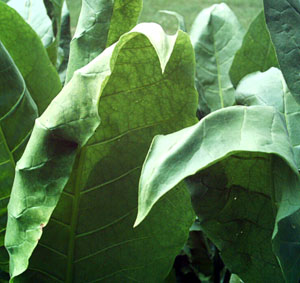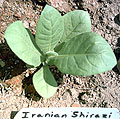Shirazi: a morphological discussion

Shirazi, classed as an Oriental tobacco, is named for the southwestern Iranian city of Shiraz. Although it has pink blossoms, its leaf shape is unlike any other Oriental that I have seen. A search of the Internet, GRIN, the Nicotiana Project (Doug Moats), and many books yielded almost no information on Shirazi, other than that it was once called Nicotiana persica, and at one time misidentified as the white-blossomed Nicotiana alata. The few photos available provided no useful size or yield information. Since I still (as of this writing) can't say how it cures, and what it tastes/smells like, I'll just discuss its appearance and growth performance.
The following data is my own. It differs significantly from the GRIN data on Shirazi.
Plant form (pyramidal, columnar, inverted cone, other): columnar
Plant length Topped - cm/in: 114 cm / 45 in
Plant length Untopped (to crowfoot) - cm/in: 150 cm / 59 in
Flower color (white, pink, red, other): pink
Flower head habit (closed, intermediate, open): closed
Leaf attachment (sessile, petiolate): sessile
Leaf carriage of midrib (arched, not arched): arched
Leaf color (light green, green, dark green): light green
Leaf margin (wavy, not wavy): not wavy
Leaf angle (upper angle between stalk and 10th leaf) - degrees: 40º
Leaf length (length of 10th leaf from bottom, at maturity) - cm/in: 56 cm / 22 in
Leaf margin (recurved, not recurved): not recurved
Leaf surface (smooth, puckered): smooth
Leaf number topped (exclude 2 bed leaves): 17
Leaf width (width of 10th leaf from bottom, at maturity) - cm/in: 27 cm / 10.5 in
Tip shape (e.g. acute, acuminate, obtuse.): acuminate
Venation pattern (square, angular): angular
Days at maturity (transplant to 50% plants 1 flower): 39
The light green, smooth leaves tend to be long, with moderate width. A unique feature of Shirazi is that the leaf tips tend to naturally cup, forming a distinct beak.

The ruffle at the base of the leaf stem almost encircles the stalk, and does not extend downward on the stalk.

My source of seed was New Hope. The germination rate was excellent, and the seedlings were quite vigorous, outgrowing my other 15 varieties this season.

The strongest of the seedlings was transplanted into a deep, 15" diameter pot of MiracleGro potting soil nearly one month before the other Shirazi seedlings were transplanted to the ground. As of two weeks ago, the potted Shirazi was only 1/2 the height of the Shirazi in the ground. The stalk of the potted Shirazi is currently about 1/2" thick, compared to 1-1/2" of the in-ground plants. (The ruler in the photos is 48 inches. Several of the plants in the ground are supported by short sticks after a blowdown.)


By comparison to Samsun and Bafra, Shirazi is not as tall, has fewer though larger leaves, and is a lighter green. The Shirazi performed better as a seedling, and grew faster and matured earlier.

I'm not sure if Shirazi is still grown in Iran, in light of the recent Islamist proscription of tobacco.
Bob

Shirazi, classed as an Oriental tobacco, is named for the southwestern Iranian city of Shiraz. Although it has pink blossoms, its leaf shape is unlike any other Oriental that I have seen. A search of the Internet, GRIN, the Nicotiana Project (Doug Moats), and many books yielded almost no information on Shirazi, other than that it was once called Nicotiana persica, and at one time misidentified as the white-blossomed Nicotiana alata. The few photos available provided no useful size or yield information. Since I still (as of this writing) can't say how it cures, and what it tastes/smells like, I'll just discuss its appearance and growth performance.
The following data is my own. It differs significantly from the GRIN data on Shirazi.
Plant form (pyramidal, columnar, inverted cone, other): columnar
Plant length Topped - cm/in: 114 cm / 45 in
Plant length Untopped (to crowfoot) - cm/in: 150 cm / 59 in
Flower color (white, pink, red, other): pink
Flower head habit (closed, intermediate, open): closed
Leaf attachment (sessile, petiolate): sessile
Leaf carriage of midrib (arched, not arched): arched
Leaf color (light green, green, dark green): light green
Leaf margin (wavy, not wavy): not wavy
Leaf angle (upper angle between stalk and 10th leaf) - degrees: 40º
Leaf length (length of 10th leaf from bottom, at maturity) - cm/in: 56 cm / 22 in
Leaf margin (recurved, not recurved): not recurved
Leaf surface (smooth, puckered): smooth
Leaf number topped (exclude 2 bed leaves): 17
Leaf width (width of 10th leaf from bottom, at maturity) - cm/in: 27 cm / 10.5 in
Tip shape (e.g. acute, acuminate, obtuse.): acuminate
Venation pattern (square, angular): angular
Days at maturity (transplant to 50% plants 1 flower): 39
The light green, smooth leaves tend to be long, with moderate width. A unique feature of Shirazi is that the leaf tips tend to naturally cup, forming a distinct beak.

The ruffle at the base of the leaf stem almost encircles the stalk, and does not extend downward on the stalk.

My source of seed was New Hope. The germination rate was excellent, and the seedlings were quite vigorous, outgrowing my other 15 varieties this season.

The strongest of the seedlings was transplanted into a deep, 15" diameter pot of MiracleGro potting soil nearly one month before the other Shirazi seedlings were transplanted to the ground. As of two weeks ago, the potted Shirazi was only 1/2 the height of the Shirazi in the ground. The stalk of the potted Shirazi is currently about 1/2" thick, compared to 1-1/2" of the in-ground plants. (The ruler in the photos is 48 inches. Several of the plants in the ground are supported by short sticks after a blowdown.)


By comparison to Samsun and Bafra, Shirazi is not as tall, has fewer though larger leaves, and is a lighter green. The Shirazi performed better as a seedling, and grew faster and matured earlier.

I'm not sure if Shirazi is still grown in Iran, in light of the recent Islamist proscription of tobacco.
Bob

